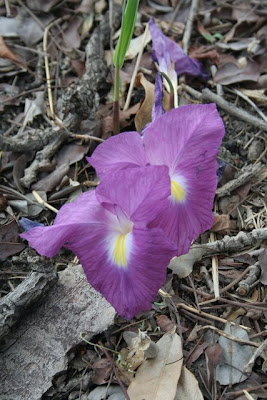
The first of the three
confluences that I visited is just a few kilometers from the Benin-Niger border, near Karimama. Technically it's inside Parc du W, a wildlife refuge that's not even remotely as developed as Park Pendjari.

Cow cart crosses the Niger River.

Tom, Kelly, and me.

The Niger River. The strip of land in the distance is Niger.
We paid a park ranger and a taximoto driver to take us into the park on their motorcycles. The park ranger was invited mostly for his gun in case of a lion attack, which turned out to be unnecessary as the only animal we saw the entire time was a single warthog. We did see a bunch of elephant tracks in the dried mud, though, and there were a lot of paths that had been created by them trampling everything in their way. The closest we could get to the confluence on the road was about 8km so we had to ride our motorcycles into the bush, which did not please the drivers. The vegetation alternated between extremely thick forest and empty, burned out patches. I'm still somewhat amazed that we got anywhere given how crappy the terrain got at some points. After about an hour we got to within 800 meters of the confluence when the park ranger's motorcycle got a flat.

We drove through this for an hour.

Me riding with the park ranger.

We walked the rest of the way and found the confluence under a tree, surrounded by the remains of what the park ranger claimed to be a prehistoric village. There were thousands of shards of old clay pots half-buried everywhere. We also found an old grinding stone which he told us was what they used before people invented the yam-smashing devices they use today to make pounded yams. The odds of this are pretty unbelievable - for the entirety of the rest of the trip we saw absolutely no signs of human civilization whatsoever.

Some pottery shards.

Half-buried pot.

The confluence (within the margin of error anyway)

12°N, 3°E is located exactly over in those dead bushes.

Me standing on the confluence. The park ranger insisted I wear a yellow shirt and not a white one so that lions wouldn't target me.

The grinding stone.

Park ranger, with shotgun
We took our pictures and returned to where the other guy was with the motorcycles. The park ranger claimed he knew a shortcut to a road, where we could then take the one good motorcycle back to Karimama. "It's only 3km away!" he said. After walking for three kilometers in the unbearable heat (it was well over 100 degrees), I asked him to show me on the map exactly where we were going. I put the coordinates in my GPS unit and it calculated that it was 14 kilometers away - six kilometers further than the park entrance we had come in through.
Just after we decided it would be better to cut our losses and hike back to the entrance, the other motorcycle got a flat. Up to that point we had been taking turns riding slowly on it as the others walked. So not only did we no longer have that option, but it slowed us down even more as the taximoto driver wasn't exactly in great shape and he couldn't push his motorcycle nearly as fast as the rest of us could walk.
About two hours later we made it back to the entrance. Our water had run out and we were exhausted. The taximoto guy pumped up his flat tire enough for him to take me and the other volunteer back to Karimama. We left the park ranger at the entrance and the taximoto driver promised to come back to bring him a tire (which he did). I downed about five liters of water when we got back but was still dehydrated. So dehydrated that it hurt to pee. The next day things were considerably better.

A little cliff

My favorite picture of the trip
www.confluence.org





















